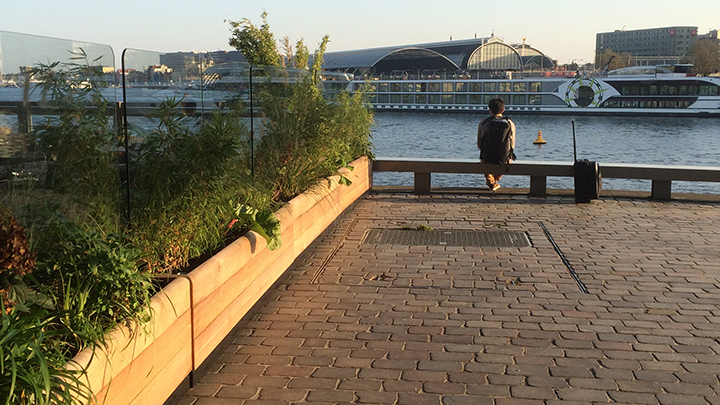News
Let flooding in Amsterdam inspire your garden

The autumn is here. The days get darker, windy and sometimes floodings occur. Due to climate change the weather forecasts are getting more and more extreme and sometimes this can have severe effects on our precious garden. At the same time our gardens can also work as a buffer to prevent flooding. We went to visit one of the most flood prone areas in the world; Amsterdam. To understand the urban garden’s role to prevent flooding. We also want to share some advice from the urban farming pioneer Stacey Murphy in New York how to avoid, and motivate yourself to restart in your garden after a weather induced disaster.
Amsterdam is known for its vulnerability when it comes to flooding. A great part of Amsterdam’s land surface is situated under sea level. For instance the airport is situated as much as 5 meters under sea level. However, Amsterdam is also known for it’s many urban farms and if you book in time you can explore the city by bike visiting urban farms with the guidance of experienced locals. In the more central parts it is harder to find urban farms than in the suburns. However, the Dutch’s love for nature can be seen in every corner of the streets.
The vegetation on the roofs, walls and ground play a vital role in the prevention of floodings even in small scale. The plants absorb the water and slowly release it through evaporation. However, how good the planting beds can absorb the water is depending on a range of different factors such as vegetation, climate and soil. As an example a thin sedum roof can almost half the stormwater runoff on a yearly basis while a roof of 5 cm thickness can reduce as much as 70 % of the stormwater according to FLL. In the image under, made by Hanna Johansson, former architect at The Foodprint Lab, you can see how big difference it is between infiltration of stormwater in asphalted urban areas and areas with more vegetation.
However, the absolutely best way to avoid flooding in your garden is to design and establish a rain garden. A rain garden can soak up as much as 30 % more than conventional lawns as well as clean the water from pollutants. When you design your rain garden it is important to think on a range of factors such as slope as well as what vegetation to choose. The vegetation need to be able to handle both drought and temporary flooding. A good strategy is to place plants that can handle wet environments in the deepest parts such as Bulrush, which is also edible, and native plants that like it dry better in the upper slopes such as strawberries, stepmother violet and back thyme. However, you should be careful that the edible plants have not been exposed to water from polluted areas before you eat them. Generally, in a temperate climate, you should avoid plants that are common in dry Mediterranean climates as Rosemarie and lavender since the small and light leafs makes the evaporation very slow, thus the risk of overwatering higher.
Five tips from Stacey Murphy to think on to prevent and adapt to flooding in your garden.
1. Create an action plan!
Identify where water was standing longer and deeper than on other places if your garden have been flooded or identify riskfull areas in advance.
2. Plan and create swales. Direct the water to another location than to your garden beds.
3. Build uplifted farming beds or build the farm on tables that you can roll in when a flooding is expected.
4. Do soil tests to make sure that pollutants from other places didn’t end up in your garden. Reboost the soil with new nutrients from ex. compost teas after the flooding.
5. Boost yourself for being a climate hero. Taking care of the soil is the best way to take care of the carbon and ensure that we will always have food.
See the video clip with Stacey Murphy about her experience of floodings in gardens and tips.Victoria Bengtsson






